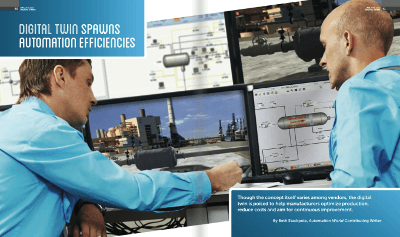You may have seen the recent announcement that Google Glass is back as Google Glass Enterprise Edition (EE) designed for workplace environments like ours in the manufacturing space. This technology joins others well established technologies such as Daqri and Gilgamesh in providing augmented reality (AR) and virtual reality (VR) solutions to support operators, technicians and other plant personnel in safely, efficiently and effectively performing their jobs.
 A recent Automation World article, Digital Twin Spawns Automation Efficiencies, describes one important application for virtual reality as a means of:
A recent Automation World article, Digital Twin Spawns Automation Efficiencies, describes one important application for virtual reality as a means of:
…creating a virtual representation of physical assets, including modeling behavior—for validation and test purposes. This process, which promises to reduce reliance on costly prototypes while accelerating time to market, is now starting to take root in the plant floor environment as a way to garner efficiencies for production and, in some cases, set the stage for predictive maintenance.
Emerson’s Ronnie Bains was one of the people interviewed for the article. Ronnie has been seeing an increase in demand for 3D/Immersive simulation, as part of multi-purpose dynamic simulation (MPDS) projects.
MPDS enables the external operator’s view to be simulated with that of the control room operator, creating a unique way to support integrated operations. A simulation model represents the dynamic operation of the process along with its controls and associated logic.
In the article, Ronnie explains that:
Emerson customers are leveraging digital twins to support the initial design of a facility, to build actual processes and control systems, and to understand whether what is being built can function at the proper throughput.
He’s quoted:
“If you’re doing something incorrectly and you don’t have such simulation, you don’t find out about the potential impact until much later in a project’s process… With a digital twin, you can identify areas of concern and design flaws early on and fix them as opposed to when things are built out and it’s more expensive.”
The article’s author notes:
As part of its Multi-Purpose Dynamic Simulator systems, Emerson’s DeltaV Simulate capabilities allow companies to test control logic and operator graphics in a virtual commissioning scenario, minimizing potential errors and streamlining the startup process. The same technology can also be leveraged to assist in training operators in unique processes.
Ronnie is quoted:
“The level to which the digital twin is applied varies from customer to customer… For some, it’s just for training; for others, it’s the full lifecycle.”
Here’s a quick peek video of a 3D immersive simulation that shows an operator checking instrumentation around a process vessel.
Visit the DeltaV simulation page for more on the technologies and services available to help in improving project and operational performance. You can also connect and interact with other simulation professionals in the DeltaV, Plan & Design and Train & Develop groups in the Emerson Exchange 365 community.





